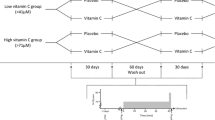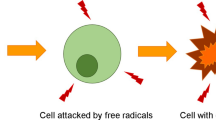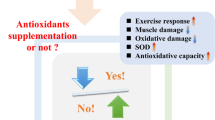Abstract
The health-promoting effects of antioxidant vitamins C and E supplementation are unclear. This study investigated the effects of vitamins C and E on the activities of reactive oxygen species (ROS)-scavenging enzymes and protein and lipid peroxidation statuses under resting and exercise-induced conditions. Thirteen healthy, previously untrained males (age 20–21 years) participated in this study. Seven subjects performed physical exercise using a cycle ergometer, and six performed a 6-min walk test (6MWT) prior to vitamin administration and after 1-week oral administration of vitamin C (1000 mg/day) and vitamin E (300 IU/day). Venous blood samples were collected before and after exercise. Plasma vitamin C concentration, superoxide dismutase (SOD) activity, glutathione peroxidase (GPx) activity, and protein carbonyl and thiobarbituric acid-reactive substance (TBARS) contents were measured. Antioxidant supplementation increased vitamin C concentration by 34% (p<0.05), decreased SOD activity by 17% (p<0.05), increased GPx activity by 13% (p<0.05), and increased the GPx/SOD activity ratio by 37% (p<0.05). Protein carbonyl and TBARS contents were unaffected. Antioxidant vitamins effectively increase the plasma GPx/SOD activity ratio, but fail to reduce protein carbonyl levels induced by exercise.
Similar content being viewed by others
References
Halliwell B., Oxidative stress, nutrition and health. Experimental strategies for optimization of nutritional antioxidant intake in humans, Free Radic. Res. 1996, 25, 57–74
Davies K.J., Quintanilha A.T., Brooks G.A., Packer L., Free radicals and tissue damage produced by exercise, Biochem. Biophys. Res. Commun. 1982, 107, 1198–1205
Commoner B., Townsend J., Pake G.E., Free radicals in biological materials, Nature 1954, 174, 689–691
Sastre J., Asensi M., Gasco E., Pallardo F.V., Ferrero J.A., Furukawa T., et al., Exhaustive physical exercise causes oxidation of glutathione status in blood: prevention by antioxidant administration, Am. J. Physiol. 1992, 263, R992–995
Goldfarb A.H., McKenzie M.J., Bloomer R.J., Gender comparisons of exercise-induced oxidative stress: influence of antioxidant supplementation, Appl. Physiol. Nutr. Metab. 2007, 32, 1124–1131
Ryan M.J., Dudash H.J., Docherty M., Geronilla K.B., Baker B.A., Haff G.G., et al., Vitamin E and C supplementation reduces oxidative stress, improves antioxidant enzymes and positive muscle work in chronically loaded muscles of aged rats, Exp. Gerontol. 2010, 45, 882–895
Xu X.M., Moller S.G., ROS removal by DJ-1: Arabidopsis as a new model to understand Parkinson’s Disease, Plant. Signal. Behav. 2010, 5, 1034–1036
Elchuri S., Oberley T.D., Qi W., Eisenstein R.S., Jackson Roberts L., Van Remmen H., et al., CuZnSOD deficiency leads to persistent and widespread oxidative damage and hepatocarcinogenesis later in life, Oncogene 2005, 24, 367–380
Muller F.L., Song W., Liu Y., Chaudhuri A., Pieke-Dahl S., Strong R., et al., Absence of CuZn superoxide dismutase leads to elevated oxidative stress and acceleration of age-dependent skeletal muscle atrophy, Free Radic. Biol. Med. 2006, 40, 1993–2004
Gomez-Cabrera M.C., Domenech E., Romagnoli M., Arduini A., Borras C., Pallardo F.V., et al., Oral administration of vitamin C decreases muscle mitochondrial biogenesis and hampers traininginduced adaptations in endurance performance, Am. J. Clin. Nutr. 2008, 87, 142–149
Powers S.K., Duarte J., Kavazis A.N., Talbert E.E., Reactive oxygen species are signalling molecules for skeletal muscle adaptation, Exp. Physiol. 2010, 95, 1–9
Higashida K., Kim S.H., Higuchi M., Holloszy J.O., Han D.H., Normal adaptations to exercise despite protection against oxidative stress, Am. J. Physiol. Endocrinol. Metab. 2011, 301, E779–784
Theodorou A.A., Nikolaidis M.G., Paschalis V., Koutsias S., Panayiotou G., Fatouros I.G., et al., No effect of antioxidant supplementation on muscle performance and blood redox status adaptations to eccentric training, Am. J. Clin. Nutr. 2011, 93, 1373–1383
Yfanti C., Akerstrom T., Nielsen S., Nielsen A.R., Mounier R., Mortensen O.H., et al., Antioxidant supplementation does not alter endurance training adaptation, Med. Sci. Sports. Exerc. 2010, 42, 1388–1395
Ristow M., Zarse K., Oberbach A., Kloting N., Birringer M., Kiehntopf M., et al., Antioxidants prevent health-promoting effects of physical exercise in humans, Proc. Natl. Acad. Sci. U. S. A. 2009, 106, 8665–8670
Nikolaidis M.G., Kerksick C.M., Lamprecht M., McAnulty S.R., Does vitamin C and E supplementation impair the favorable adaptations of regular exercise?, Oxid. Med. Cell. Longev. 2012, 2012, 707941
Halliwell B., Biochemistry of oxidative stress, Biochem. Soc. Trans. 2007, 35, 1147–1150
Retana-Ugalde R., Casanueva E., Altamirano-Lozano M., Gonzalez-Torres C., Mendoza-Nunez V.M., High dosage of ascorbic acid and alphatocopherol is not useful for diminishing oxidative stress and DNA damage in healthy elderly adults, Ann. Nutr. Metab. 2008, 52, 167–173
Shargorodsky M., Debby O., Matas Z., Zimlichman R., Effect of long-term treatment with antioxidants (vitamin C, vitamin E, coenzyme Q10 and selenium) on arterial compliance, humoral factors and inflammatory markers in patients with multiple cardiovascular risk factors, Nutr. Metab. (Lond) 2010, 7, 55
Salonen J.T., Nyyssonen K., Salonen R., Lakka H.M., Kaikkonen J., Porkkala-Sarataho E., et al., Antioxidant Supplementation in Atherosclerosis Prevention (ASAP) study: a randomized trial of the effect of vitamins E and C on 3-year progression of carotid atherosclerosis, J. Intern. Med. 2000, 248, 377–386
Lapointe A., Couillard C., Lemieux S., Effects of dietary factors on oxidation of low-density lipoprotein particles, J. Nutr. Biochem. 2006, 17, 645–658
Hercberg S., Kesse-Guyot E., Druesne-Pecollo N., Touvier M., Favier A., Latino-Martel P., et al., Incidence of cancers, ischemic cardiovascular diseases and mortality during 5-year follow-up after stopping antioxidant vitamins and minerals supplements: a postintervention follow-up in the SU.VI. MAX Study, Int. J. Cancer 2010, 127, 1875–1881
Omar B.A., McCord J.M., The cardioprotective effect of Mn-superoxide dismutase is lost at high doses in the postischemic isolated rabbit heart, Free Radic. Biol. Med. 1990, 9, 473–478
Rosen D.R., Siddique T., Patterson D., Figlewicz D.A., Sapp P., Hentati A., et al., Mutations in Cu/Zn superoxide dismutase gene are associated with familial amyotrophic lateral sclerosis, Nature 1993, 362, 59–62
Amstad P., Peskin A., Shah G., Mirault M.E., Moret R., Zbinden I., et al., The balance between Cu,Znsuperoxide dismutase and catalase affects the sensitivity of mouse epidermal cells to oxidative stress, Biochemistry 1991, 30, 9305–9313
Amstad P., Moret R., Cerutti P., Glutathione peroxidase compensates for the hypersensitivity of Cu,Zn-superoxide dismutase overproducers to oxidant stress, J. Biol. Chem. 1994, 269, 1606–1609
Park E.M., Ramnath N., Yang G.Y., Ahn J.Y., Park Y., Lee T.Y., et al., High superoxide dismutase and low glutathione peroxidase activities in red blood cells predict susceptibility of lung cancer patients to radiation pneumonitis, Free Radic. Biol. Med. 2007, 42, 280–287
Nakhostin-Roohi B., Barmaki S., Khoshkhahesh F., Bohlooli S., Effect of chronic supplementation with methylsulfonylmethane on oxidative stress following acute exercise in untrained healthy men, J. Pharm. Pharmacol. 2011, 63, 1290–1294
Author information
Authors and Affiliations
Corresponding author
About this article
Cite this article
Tomoeda, M., Kubo, C., Yoshizawa, H. et al. Role of antioxidant vitamins administration on the oxidative stress. cent.eur.j.med 8, 509–516 (2013). https://doi.org/10.2478/s11536-013-0173-6
Received:
Accepted:
Published:
Issue Date:
DOI: https://doi.org/10.2478/s11536-013-0173-6




